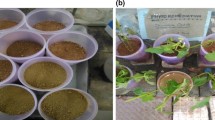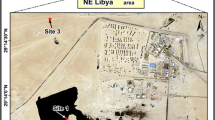Abstract
Produced water is water trapped in underground formations that is brought to the surface along with oil or gas production. Oilfield impacted soil is the most common environmental problem associated with oil production. The produced water associated with oil-production contaminates the soil and causes the outright death of plants, and the subsequent erosion of topsoil. Also, impacted soil serves to contaminate surface waters and shallow aquifers. This paper is intended to provide an approach for full characterization of contaminated soil by produced water, by means of analysis of both the produced water and the impacted soil using several recommended analytical techniques and then identify and assay the main constituents that cause contamination of the soil. Gialo-59 oilfield (29N, 21E), Libya, has been chosen as the case study of this work. The field has a long history of petroleum production since 1959, where about 300,000 bbl of produced water be discharged into open pit. Test samples of contaminated soil were collected from one of the disposal pits. Samples of produced water were collected from different points throughout the oil production process, and the analyses were carried out at the labs of Libyan Petroleum Institute, Tripoli, Libya. The results are compared with the local environmental limiting constituents in order to prepare for a plan of soil remediation. The results showed that the main constituents (pollutants) that impact the soil are salts and hydrocarbon compounds. Accordingly; an action of soil remediation has been proposed to remove the salts and degradation of hydrocarbons.
Similar content being viewed by others
References
Abdul Hamid, H. R. (2004). Investigation and remediation of contaminated soil by oil-field produced water. M.Sc thesis, International Technological University (ITU), London, UK.
Deuel, L. E., & Holliday, G. H. (1997). Soil remediation for the petroleum extraction industry (2nd ed.). Tusla, Oklahoma: PennWell.
Epstein, P. R., & Selber, J. (2002). ‘Oil’ a life cycle analysis of its health and environmental impacts. The Center for Health and the Global Environment, Harvard Medical School. (Available at: http://www.med.harvard.edu/chge/oil.html).
PEC (1999). Survey of technology for remediation of oil-contaminated soil in Kuwait. by Staff of Petroleum Energy center, Japan.
Veil, J. A., Puder, M. G., Elcock, D., & Redweik, R. J. (2004). A white paper describing produced water from production of crude oil, natural gas and coal bed methane. Prepared for U.S. Department of Energy and National Energy Technology Laboratory, January.
Author information
Authors and Affiliations
Corresponding author
Rights and permissions
About this article
Cite this article
Abdol Hamid, H.R., Kassim, W.M.S., El Hishir, A. et al. Risk assessment and remediation suggestion of impacted soil by produced water associated with oil production. Environ Monit Assess 145, 95–102 (2008). https://doi.org/10.1007/s10661-007-0018-3
Received:
Accepted:
Published:
Issue Date:
DOI: https://doi.org/10.1007/s10661-007-0018-3




